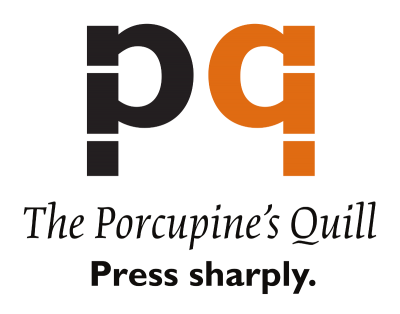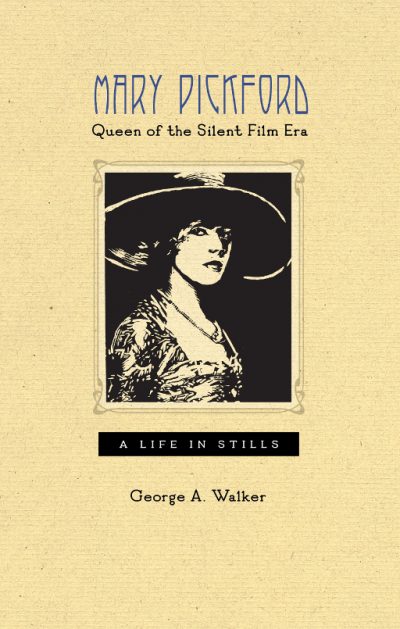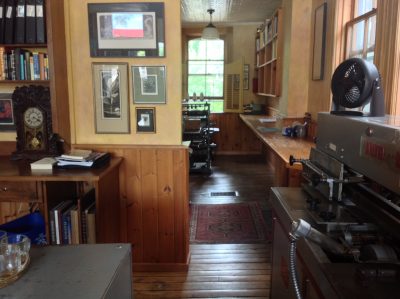
Founders
The Porcupine’s Quill is owned and operated by Tim and Elke Inkster, who live above the printing shop which is housed in two Victorian commercial buildings on the Main Street of Erin Village, a rural backwater in Wellington County.
Tim Inkster is a professional member of the Graphic Designers of Canada and has over forty years of experience in book design and publishing. He has won silver and bronze medals in Leipzig for his book design, and has received a commendation from the Art Directors’ Club of New York. Inkster is cited in Robert Bringhurst’s The Surface of Meaning: Books and Book Design in Canada as the most celebrated book designer in the country, with over 43 citations from the Alcuin Society. He is likely the one publisher in Canada who operates the Heidelberg KORD offset press himself. In 2013, Tim Inkster and received the Sixth Annual Janice Handford Award, which honours “significant contribution to the advancement of small press publishing in Canada.”
Tim and Elke Inkster have been recognized for their efforts in the field of Canadian publishing. In May 2009, they were invested into the Order of Canada “For their distinctive contributions to publishing in Canada and for their promotion of new authors, as co-founders of the Porcupine’s Quill, a small press known for the award-winning beauty and quality of its books.” In February 2012, the Inksters received the Queen Elizabeth II Diamond Jubilee Medal and in 2020, they were awarded the eleventh Robert R. Reid Award and Medal for lifetime achievement in the book arts in Canada by the Alcuin Society.
Tell us a bit about your press. How did you start? Who are your influences, in Canada and beyond? What is your mission?
The Porcupine’s Quill was incorporated in 1974, originally as the production arm of Dave Godfrey’s Press Porcépic. The company evolved into a small press in its own right—an artisanal book publisher that values the art and craft of the book in form and content. The press is located in Erin, Ontario, a nineteenth-century mill town on a branch of the West Credit River that was once populated by a First Nations community called the Attawandaron, who spoke a dialect of Iroquois.
We published our first title, Brian Johnson’s Marzipan Lies, in 1975. In the early days we started by acquiring slim volumes of poetry. We later branched into fiction, acquiring works by Canadian authors whose voices were new, underrepresented or verging on oblivion. Over the years we have focused on books that represent the intersection between literature and other creative disciplines: between text and image, memoir and music, letterpress and offset. Our selectively acquired fiction and poetry features authors at all stages of their careers, and our non-fiction reaches beyond literature into music, art, pop culture and politics. We are proud to be one of very few presses in Canada to produce wordless novels and popularly priced trade replicas of hand-printed, limited edition artists’ books.
Our mandate is to preserve the culture of the printed word by applying our expertise in the art of 20th-century offset printing technology in the creation of high-quality books that look and feel like 19th-century letterpress products. Most of the production work is completed at the shop on Main Street in Erin Village, where books are printed on a twenty-five-inch Heidelberg KORD, folded, and then sewn into sig natures on a 1905 model Smyth National Book sewing machine.
What about small press publishing is particularly exciting to you right now?
In a publishing landscape dominated by American blockbusters, it is important for Canadians of all backgrounds to have a voice. Small presses lead the way in discovering emerging authors, nurturing their talent, and bringing them to the attention of audiences nationwide, but they also play a role in publishing underappreciated mid-careerists and in preserving the works of pillars of the literary canon. Small presses are able to take on those projects that tend to be passed over by the larger, more commercial houses, which serves to make Canadian literature richer than ever.
Small presses are also suited to take risks, to be agile and to respond to shifts in trends. They have been proactive in seeking out diverse stories, in tackling important topics and themes and in establishing or championing experimental forms. Small presses are like little literary laboratories—they are where the excitement happens!
How does your press work to engage with your immediate literary community, and community at large?
Traditionally we have engaged with the literary community through events such as launches and readings as well as festivals and book fairs where we can interact directly with our readership. We have been known as something of a publishers’ publisher due to our interest in the craft of printing, and our focus in the printing arts through our journal, The Devil’s Artisan. With the current pandemic curtailing many such plans, we have redoubled our efforts to reach readers digitally, whether it be on social media, through our blog, or through our monthly email newsletter. We try to share a wide variety of content and spark conversations that are of interest to readers, writers, designers, typographers and generally book lovers of all stripes.
How have the current multiple global crises impacted your work with the press?
Like many other small presses, the COVID-19 pandemic hit us financially and caused us to cancel a number of book launches, readings and signings where we typically enjoy many of our sales. Though we do our printing in house, we also found ourselves subject to inevitable delays, which caused publication dates to creep a little more than we might like. But we are encouraged that we are slowly getting back on track, and we are beginning to see our fall books come to fruition.
In addition, though we have always sought to publish a variety of Canadian voices, the Black Lives Matter protests have encouraged us to redouble our efforts to seek works by authors of diverse backgrounds to fill our future lists.

Mary Pickford, Queen of the Silent Film Era
George A. Walker
April 23, 2020
George A. Walker’s Mary Pickford, Queen of the Silent Film Era tells the story of the Toronto-born film star who pioneered the roles of the independent actress, film star, producer, distributor and the first woman to create her own film corporation. The way that Walker tells her tale is compelling and unique. The story of her life is communicated through the medium of wood engravings, in a visual, sequential narrative not unlike the silent films of old.
Mary Pickford, Queen of the Silent Film Era originated as a limited edition of 35 copies hand printed in Walker’s studio in Leslieville, Toronto.

Fair
Ed Seaward
June 22, 2020
Ed Seaward’s debut novel Fair tells the lyrical, heartrending story of Eyan, a vulnerable young homeless man struggling to survive on the streets of L.A, and the erudite and tragic figure known as ‘the professor’, who takes Eyan under his wing. This story shines a spotlight on the struggles of homeless youth—from gang violence and fear to loneliness and despair. It shows that beauty, purity and innocence that can be found even in hellish places like Skid Row, and it speaks the human need for home and companionship, which resonates especially in these days of isolation and uncertainty.

Affect
Charlene Elsby
October 1, 2020
Charlene Elsby’s Affect is part love story, part philosophical thrill ride. The novel follows a hyper-rational philosophy graduate student who is obsessed with two things: death, and a man named Logan. Their relationship develops through a series of surreal events, in which corpses appear with disturbing frequency. This book examines and interprets, in prose that is spare, poetic and philosophical, how we think about life and death, time and distance, and the deeply affecting effects of an intense entanglement. You’ve never read a book like this!
